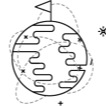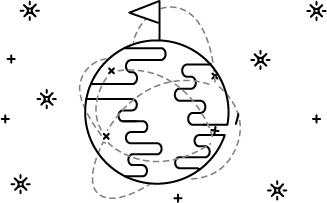Transform World: A Starfish Structure

The contexts around us are changing rapidly. Organizational structures can’t hope to keep up with these rapid changes. As a documentation of effectiveness, most organizational structures look back, not forward.
Structures are usually built to protect a “brand,” exercise quality control, enhance communication, secure property, or perpetuate and replicate processes. One needs a “brand” if the organization is raising capital from a broader public. Our natural default position when something good happens is to “program or package it” so that it can be scaled up.
Structure and leadership consume a greater amount of resources. Tim Keller has said:
An organization is more top-down, structured and controlling. Movements are more grass roots, dynamic and collaborative. Movements are dynamic, self-propagating, and encouraging to others to start similar efforts, without owning them.
We have decided that we are not going to try to protect our “brand” of transformation. Transform World Connections (TWC) does not seem to have any of those functional needs except to possibly enhance communication.
The base of a movement in today’s world is a committed core of people who trust and respect one another and apply their gifts and creativity to God’s common existential calling on their lives. There will always be movements of people into and out of the motivational and empowering circle because of very permeable, shifting, and porous boundaries. Diversity of gifts, experience, and background within the core provide a necessary flexibility to keep renewal going. This diversity must be protected and nurtured since the natural tendency of the core is to homogenize.
Starfish versus Spider
The “Starfish” ministry empowers all of God’s people (paid and volunteer) to participate in God’s work. (See the sidebar below for a definition of the Starfish model.) Prayer is foundational. To facilitate effective “Starfish” and servant paradigms, we very much need God’s continued help. The “Starfish” ministry encourages greater dependence on God. This does not negate the need for structure and leadership, but they should not be overpowering. Wherever leadership is needed it is expressed in servanthood and humility, with dependence on and glory given to God.
Positional leadership may not be essential but there must be appropriate and acknowledged leadership. Leadership is functional and not necessarily positional and may shift from person to person in the core as the challenges to the movement change.
Decentralization is the best model only when parts are connected by connecting ministries. To the extent that the “Starfish” is a structural response to the Movement’s needs, it is a helpful concept. It is, however, a “means” and not some static ideal structure we are aiming to build. It is much more dynamic than that.
Transform World Connections Embraces Starfish Organizational Model
Transform World pursues a “Starfish” type of ministry. The TWC core maintains vision and values. In TWC we have said that we want to trust the Holy Spirit for many of those functions.
Many others will plug in and pull out as their personal calling and vision find resonance with and enhances the vision and values of the core and as they are useful and fulfilled. We have stated we will follow the Holy Spirit’s  quickening of individuals who “get it.”
quickening of individuals who “get it.”
Transform World events serve as a platform where God’s vision of global transformation is being cast, not where the details are controlled.
TWC events play a role as platforms of sharing knowledge, experience, inspirations, ideas and relationships, while the focus groups serve as communities of servant catalysts and set up practical agendas for local and global transformation.
Toward a Committed Core: Trust, Honest Communication, Commitment, Accountability and Attention to Results
Honest communication, meaningful interaction, and successful execution of the vision constitute the currency or fuel that drives the network.
We are being called to build a committed core to respond to the mega challenges.
The Starfish and the Spider: Catalysts Rule!
In many arenas, a lack of traditional leadership is giving rise to powerful groups such as al Queda, Craigslist and Napster that are turning industry and society upside down. I liken these groups to a starfish. Businesses, institutions, governments and individuals (exemplified by the spider) must realize that starfish and spiders may look alike, but starfish have a powerful and miraculous quality. Cut off a spider’s leg and you have a seven-legged creature; cut off its head and it dies. But cut off the arm of a starfish and it grows a new one. Plus its severed arm is capable of generating an entirely new body!
Today starfish organizations are taking society and the business world by storm, changing the rules of strategy, engagement and competition. In the book The Starfish and the Spider, we use the spider as a metaphor for organizations and business models with the traditional structure of a rigid hierarchy and top-down leadership, and the starfish to represent organizations based on peer relationships and a catalyst style of leadership. We give many examples in the book of successful starfish-like organizations, along with several stories of how traditional “spider” companies have suffered when faced with “starfish” competition.
Rod Beckström
Author of The Starfish and the Spider: The Unstoppable Power of Leaderless Organizations. Excerpted from entry at http://rthk.hk/mediadigest/20071215_76_121670.html
The Starfish and the Spider
The Starfish and the Spider: The Unstoppable Power of Leaderless Organizations, a 2006 book by Ori Brafman (author of the 2010 book Click: The Magic of Instant Connections ISBN 978-0-385-52905-1) and Rod Beckstrom, is an exploration of the implications of the recent rise of decentralized organizations such as Wikipedia, Grokster and YouTube. The book contrasts them to centralized organizations, such as Encyclopædia Britannica, using compendia of knowledge as examples. The spider and starfish analogy refers to the contrasting biological nature of the respective organisms, starfish having a decentralized neural structure permitting regeneration.
In addition to giving historical examples of decentralized organizations such as Alcoholics Anonymous and the Apaches, and analyzing their nature in contrast to centralized organizations, the book considers conflict between centralized and decentralized organizations, including the “If you can’t beat them, join them” solution to creating hybrid organizations such as Citizendium.[citation needed] A chapter towards the end of the book explores the concept of the “sweet spot,” the optimal mix of decentralized and centralized attributes.
Catalysts
The book identifies a set of people the authors call “catalysts” who tend to be skilled at creating decentralized organizations. The authors list several abilities and behaviors (called “The Catalyst’s Tools”) that “catalysts” have in common, including:
- Genuine interest in others.
- Numerous loose connections, rather than a small number of close connections.
- Skill at social mapping.
- Desire to help everyone they meet.
- The ability to help people help themselves by listening and understanding, rather than giving advice (“Meet people where they are”).
- Emotional Intelligence.
- Trust in others and in the decentralized network.
- Inspiration (to others).
- Tolerance for ambiguity.
- A hands-off approach. Catalysts do not interfere with, or try to control the behavior of, the contributing members of the decentralized organization.
- Ability to let go. After building up a decentralized organization, catalysts move on, rather than trying to take control.
“A leader is best when people barely know that he exists; not so good when people obey and acclaim him; worst when they despise him.” (p. 115) (Lao-tzu)
“As a catalyst, it’s all about letting go and trusting the community.” (p. 111)
Catalyst Examples
The book talks about “catalysts,” the people who found a starfish group and give it form, ideas, value, focus, and meaning. Some examples of such human catalysts in the book include:
- Granville Sharp, leader of the abolitionist movement against slavery in England
- Elizabeth Cady Stanton, who founded the women’s suffrage movement that Susan B. Anthony later took up with still greater energy
- Craig Newmark of Craigslist
- Bill Wilson of Alcoholics Anonymous
- Jimmy Wales of Wikipedia
The Ten Rules
The ten “rules” are:
- Diseconomies of scale–small companies have power.
- Network effect–every additional person makes the organization stronger.
- Power of chaos.
- Knowledge at the edge–information about the organization is open to everybody.
- Everyone wants to contribute–self-motivated employees.
- Beware the hydra response.
- Catalysts rule.
- Values are the heart of any organization or network.
- Measure, monitor, and manage.
- Flatten or be flattened.
(Taken from Wikipedia)









comments